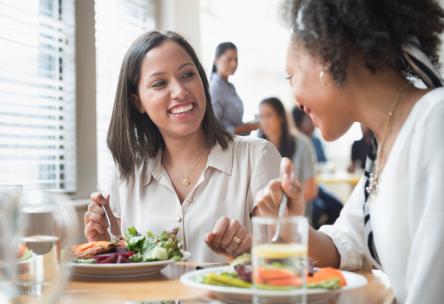Expert tips to help you stay careful and safe when going out to eat

If you’re planning on grabbing dinner with a friend, you might think it’s a good idea to cut back on carbs for the earlier part of the day. However, according to Kristen Smith, M.S., R.D., a spokesperson for the Academy of Nutrition and Dietetics and founder of the blog 360FamilyNutrition, that’s not recommended—for people with or without diabetes.
“You want to keep your carbohydrate intake consistent throughout the day to avoid a spike in blood sugar,” Smith says. But she also acknowledges that “[s]till, you have to remember that carbohydrates aren’t ‘free’ when you eat out. They’re still part of your overall intake for the day.”
So, in order to prepare for the restaurant meal ahead of time, and order wisely during it, Smith recommends the following:
1. Plan Your Meals in the Morning
“People who have the best success with eating in general—and dining out, specifically—are those who make meal planning part of their lifestyle,” says Smith. This doesn’t have to be time-consuming. When you wake up, run through your day as you shower and dress. Have a hectic evening ahead? You can plan to grab something quick for dinner. But if you plan for it, you can make a better choice about what that “something quick” will be.
2. Decide What to Eat Before You Get There
The FDA requires that chain restaurants list nutritional information for their menu items. Menus (on paper as well as on the overhead boards) list calories, and other information including carbohydrates and sugars are available on request. You can also often find detailed nutritional information on restaurants’ websites. It can help to plan ahead of time, Smith advises, rather than waiting to decide when you’re seated (and possibly “hangry”).
3. Use Your Hand as a Portion Guide
You could feed an elephant with many of the huge platters served these days. “At a restaurant, you’re probably not going to pull out your measuring cups,” says Smith. These visualizations, which are based on the size of an average woman’s hand, can help. (Hand size varies, so use measuring cups and spoons at home to figure out the size of your own fist, thumb, etc.)
* 1 teaspoon = thumb from tip to first joint
* 1 tablespoon = entire thumb
* 1/2 cup (fruit, veggies, grains) or 4 ounces (meat, fish) = the palm
* 1 cup = a closed fist
4. Account for Hidden Sugars
Sure, the dessert case and soda fountain are basically big sugar bowls, save a few sugar-free choices. But did you know that those ketchup and barbecue-sauce bottles on the table contain added sugar, too? Smith advises asking for condiments on the side. (Using less of them usually lowers your sodium intake as well.) Even a salad might sneak in a bit of the sweet stuff if it’s made with candied nuts and dried or fresh fruit, so pay attention to each ingredient.
5. Avoid Carb-Filled Drinks
Soda, juice, and fruity drinks are sugar bombs. “I tell people to stay away from them because they are a carbohydrate source that won’t help you feel full,” says Smith. “Fortunately, there are lots of lower-calorie and calorie-free options.” Diet soda, and unsweetened iced tea, hot tea, and coffee are available at most restaurants. If there’s a bar, you can also order a seltzer with a lemon, lime, or orange wedge.
A few more quick tips:
- Ask for one piece of bread instead of a whole basket.
- Order an appetizer, small plate, or half-portion size instead of a full entrée.
- Ask for a to-go container. Box up half of your meal before you dig in.
- Split dessert or ask for something sugar-free. (Keep in mind that sugar-free doesn’t mean carb-free.)